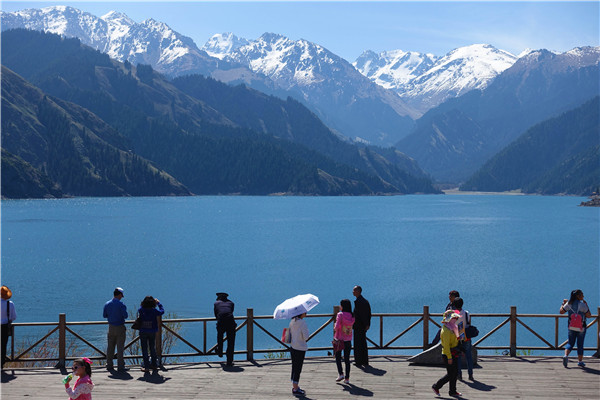Tourism outpaces luxury goods
 |
|
The Heavenly Lake in Xinjiang's Changji Hui autonomous prefecture.[Photo by Zhu Xingxin/China Daily] |
Ctrip's 2015 first-quarter operating income surged 46 percent year-on-year to 2.4 billion yuan. Hotel reservations rose 60 percent. And transportation-ticket bookings more than doubled, Ctrip reports.
Traveler's expenditures exceeded 13 billion yuan during the period, the agency says.
Rapidly decreasing travel costs and increasing incomes are fueling the boom.
Most weekend outings cost under 1,000 yuan. And tours to China's East Asian neighbors, such as Japan and South Korea, are possible at around 2,000 yuan, thanks to discounted flights and hotels.
Urban Chinese per-capita disposable income reached 28,844 yuan last year, a 9 percent year-on-year increase, the National Bureau of Statistics reports. The figure broke 40,000 yuan in Shanghai, Beijing, coastal Zhejiang province and Guangdong province's Shenzhen city, a manufacturing hub.
"The online travel business still has a lot of room to grow in the market, considering China's per-capita travel consumption accounts for less than 10 percent of the US'," says Ctrip's CEO, Liang Jianzhang.
Travel income is expected to grow as China goes all out to develop travel.
The national tourism administration has launched a series of measures, including upgrading public toilets, blacklisting uncivil tourist behavior and redressing tour-guide misconduct.
Last year, the State Council proposed targets according to which domestic tourists will spend 5.5 trillion yuan annually by 2020, more than double 2013's total, to account for 5 percent of the country's GDP.
Beijing has been wooing tourists with its 2012 adoption of a 72-hour visa-free transit policy for foreigners from 45 countries. And 14 other Chinese cities have followed suit, the Shenzhen Economic Daily reports.
Visitors can spend up to 72 hours in these cities after flying in, provided they have third-country visas and tickets to their next destinations.














